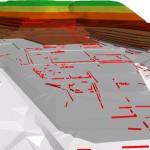 Data collected in 2009 as part of the Computer Modeling of Heritage Resources, Peru.
Data collected in 2009 as part of the Computer Modeling of Heritage Resources, Peru.
2009 CAST-UCLA Cotsen Institute’s “Modeling Heritage Resources” field program took place in the city of Cuzco (or Cusco), Peru in collaboration with the Instituto National de Cultura (INC) and Vladimir Davilis, director of P.A.N. Machupicchu, director of Regional de Cultura Cusco. Cuzco, the capital of the Inca empire, is much like modern day Rome. With modern day buildings resting on Incan foundations, water flowing through Incan canals, and a city layout in the shape of a Puma, the city of Cuzco is in and of itself an archaeological site worthy of study.
For Raster formats, we recommend ArcMap and for .obj polygonal mesh, we recommend Rapidform EXPLORER.
View Cuzco GIS and RS in a larger map
Please note. This data is distributed under a Creative Commons 3.0 License (see http://creativecommons.org/licenses/by-nc/3.0/ for the full license). You are free to share and remix these data under the condition that you include attribution as provided here. You may not use the data or products in a commercial purpose without additional approvals. Please attach the following credit to all data and products developed there from:
Credit: Instituto Nacional de Cultura, Center for Advanced Spatial Technologies, (University of Arkansas) and Cotsen Institute for Archaeology (UCLA)
Longer version: Data developed under the authority of the Instituto Nacional de Cultura, Vladimir Dávila – Arquitecto del P.A.N Machu Picchu, Director del P.A.N Machu Picchu Direccion Regional de Cultura Cusco and Fernando Astete – National Archaeological Park of Machu Picchu. Data acquired, processed and distributed by the Center for Advanced Spatial Technologies staff (Snow Winters, Malcolm Williamson and Katie Simon) and by students in the 2009 Cotsen Institute for Archaeology (UCLA) Cuzco/Machu Picchu Field School, Alexei Vranich Director.